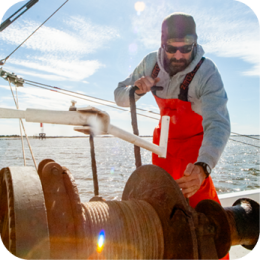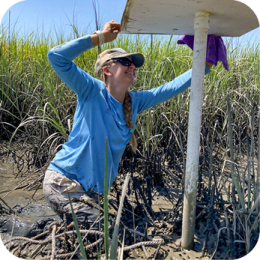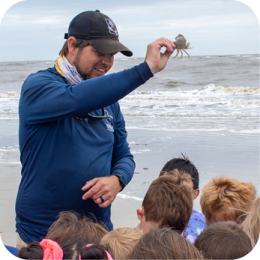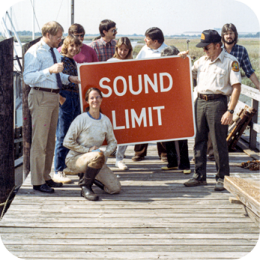These grants focus on developing and improving wildlife-viewing opportunities that increase public awareness and appreciation of wildlife not hunted or fished for, rare native plant species and natural habitats. The program also emphasizes species and habitats considered conservation priorities in Georgia’s State Wildlife Action Plan.
Wildlife viewing is big in Georgia. More than 4.8 million residents – about 57 percent of Georgians 16 and older – took part in 2022. Resident and non-resident viewers, a combined group sized at 7.5 million, spent more than $10 billion on food, lodging, transportation, equipment and other items. Nationwide, the number of people involved in wildlife viewing surged to 148 million in 2022. Related spending topped an estimated $250 billion.
Learn more about wildlife viewing, survey insights and grant projects on the wildlife viewing page.
Grants FYI
- Eligibility
Applicants can include local governments, nonprofit or not-for-profit organizations, and for-profit entities. If the project is proposed by a for-profit entity, the applicant must describe how it is not directly linked to the profit of the entity. Federal and state agencies, including state universities and other DNR divisions, are not eligible. However, project proposals by nonprofit or not-for-profit organizations, such as a friends group or foundation, and local governments can involve federal and state agencies and their properties.
DNR wildlife viewing grant recipients from the previous grants cycle as well as recipients whose project required a DNR extension into the previous cycle are ineligible to apply again for one year.
Nongame wildlife means species of flora and fauna indigenous to Georgia and not legally taken through hunting, fishing, trapping or otherwise (without required permits). For grant proposals, nongame must either a) be wild and free-ranging, b) part of a permitted captive breeding program to reintroduce a depleted indigenous species into a previously occupied range (otherwise, animals in enclosures are ineligible) or c) involve planting native species to create or enhance natural habitats.
It is the responsibility of grant applicants to understand and abide by program guidelines.
- Funding
Grant proposals are limited to a maximum of $5,000. Funding from DNR will be provided in the form of reimbursement for allowed expenditures.
- Proposal Requirements
Proposals should include the following (the online proposal form features these fields):
- Project title.
- Organization name, contact person and title, physical address, phone, and email.
- A brief description explaining the project location, design, objectives, methods, timeline, innovative aspects, targeted audience(s) – including underserved groups – and what Georgia State Wildlife Action Plan or other nongame wildlife species, natural habitats and conservation actions will be emphasized and how.
- Expected use, results and benefits, including details on accessibility and whether the project meets a significant wildlife-viewing need in the community.
- Costs (please provide an itemized budget).
- Support for (including cash or in-kind match) and partners involved in the project.
- Details on how the project will be maintained long-term (funding, personnel, etc.).
- A conceptual sketch of proposed signage – if signage is part of the grant request – is encouraged. Also, photos that show the site or illustrate the proposal are welcomed. Selected applicants may be required to submit additional information.
- Timeline
Feb. 4, 2026 (EST 11:59 p.m.): Deadline to submit proposals online using the proposal form. Proposals filed afterward will not be considered.
(After you submit the online form, a copy will be automatically emailed to you. Note: Spam filters sometimes intercept these messages. Also, within two business days you should receive an email from DNR confirming your submission. If you do not receive this confirmation, contact DNR communications specialist Rick Lavender, (706) 557-3327 or rick.lavender@dnr.ga.gov. It is contingent upon applicants to ensure their proposal is received.)
March 16, 2026: The contact person for proposals selected for funding will be notified. Selected applicants may be required to submit additional information.
Nov. 10, 2026: 2026 grant projects that will not be finished by Dec. 1, 2026, can request an extension by this date. Requests must be made in writing (email or mail) and received by the Wildlife Viewing Grants Program coordinator by Nov. 10 – 15 business days before the Dec. 1 deadline. The decision on whether to grant an extension is solely up to DNR Wildlife Conservation Section administration.
Dec. 1, 2026: Grant recipients are required to spend the grant award as specified in the project proposal by this date. Within 30 days of completing the grant-funded portion of the project as specified in the proposal, recipients must provide an invoice of the grant funds spent to the Wildlife Conservation Section, along with documentation of the work (item or contractor invoices, photographs, etc.) and a project summary via the project report template (Word Doc).
July 1, 2027: If the proposal is part of and dependent on the completion of a larger project, the larger project must be completed by this date, and within 30 days of completion, a project summary provided via the project report template (Word Doc).
- Review Criteria
A panel of Wildlife Conservation Section staff will evaluate eligible proposals on these criteria:
- Does the project inform the public primarily through viewing opportunities of species, habitats and conservation actions considered conservation priorities in Georgia’s State Wildlife Action Plan (2025 revision)? If so, briefly describe each.
- Does the project include significant matching funds or in-kind contributions from the applicant or other organizations?
- Are project goals clearly defined and the approach and schedule realistic?
- Will the project allow public use with no or little negative impact on the resource?
- What is the project’s potential for high public use? High use generally involves an outstanding wildlife viewing site or one that is near a population center. Low use offers no outstanding viewing site and is not near a population center.
- Does the project have funding and personnel to maintain it long-term after completion?
- Also: Does the project target an underserved audience or audiences? Does it meet a significant wildlife-viewing need in the community? Does the project provide a creative or innovative experience or wildlife-viewing approach? Does it involve collaborating with partners to raise public awareness of State Wildlife Action Plan priorities? Does the interpretive material rely on sound scientific principles? Is there a realistic strategy designed to attract viewers?
Preference will be given to projects that:
- Address priority species and habitats in the State Wildlife Action Plan.
- Provide significant opportunities for the public to experience such species and habitats without
negatively impacting the resource. - Include significant matching funds and other resources and involvement from applicants and
partners. - Exhibit strong planning, creativity and support for maintaining the projects long-term.
- Target traditionally underserved audiences or meet significant wildlife-viewing needs.
Although DNR Wildlife Conservation Section biologists and other staff cannot be involved in writing proposals, applicants can consult staff about projects and their appropriateness regarding the resource and possible impacts. (Applicants should allow sufficient time if requesting feedback from biologists.)
The contact person for projects selected for funding will be notified by March 16, 2026.
- State Wildlife Action Plan
Created in 2005 and revised in 2015 and 2025, as required by the U.S. Fish and Wildlife Service, Georgia’s State Wildlife Action Plan is a statewide strategy to conserve populations of native wildlife species and the natural habitats they need before these animals, plants and places become rarer and more costly to conserve or restore. The plan uses the best available data to provide a comprehensive, adaptable assessment of conservation needs and the best ways to address them.
Created by more than 100 partners and stakeholders, the 2025 plan revision lists about 1,060 animal and plant species as “species of greatest conservation need” and the habitats essential for conserving them. The conservation actions recommended focus efforts where they’re most needed and most effective.
Details, including a summary, a guide to the plan and priority species and habitats by ecoregions, major river basins and taxonomic group, are available at the Wild Georgia Conservation Hub.
- Content and Credits
Signage and interpretive materials produced as part of a grant and referencing wildlife, habitats and Georgia’s State Wildlife Action Plan must be submitted to the Wildlife Viewing Grants Program for review before production (this is in addition to any conceptual images of signage included as part of the initial grant proposal). Please provide sufficient time for reviewing drafts and making changes.
Grant recipients also must credit the grant provider (either the Georgia Department of Natural Resources’ Wildlife Resources Division or DNR’s Wildlife Viewing Grants Program) and reference the State Wildlife Action Plan in signage, materials, media announcements and other education or outreach describing the project.
Suggested credit: Project funding provided in part by the Georgia Department of Natural Resources’ Wildlife Viewing Grants Program, in accordance with the State Wildlife Action Plan. The plan is a comprehensive strategy to conserve native species and the habitats they need before these animals, plants and places become more rare and costly to conserve or restore.
Projects must be available for site visits by DNR staff.
Contact Rick Lavender (706-557-3327, rick.lavender@dnr.ga.gov) for logos and usage guidelines, as well as further details on naming conventions regarding DNR and the State Wildlife Action Plan.
Resources
- Grant Recipients
- Contacts
For general grant questions, contact Rick Lavender at rick.lavender@dnr.ga.gov, (706) 557-3327.
For questions about forms or reports, contact Courtney Davis, courtney.davis@dnr.ga.gov, 706.557.3302.
- Previous Projects
Also see the interactive map below.







